Contrary to popular modern belief, Leica cameras were plentiful back in the 1950s when I first started. Indeed the camera shops had windows full of them. The only trouble is that they were all pre-war or the spoils of war. As this was a time when Britain had to export or die, the last thing our government wanted anyone to do was import foreign goods, and especially not from any country which until very recently had been a bitter enemy.
 Press camera, 1950s style: Don’s red-dial and delayed-action 1954 Leica IIIf and 1954 50mm f/1.5 Summarit lens fitted with its unique lens hood. Note the ca.1954 ROSUL viewfinder which has frames for 5cm, 9cm and 13.5cm lenses. In its day this was a vital accessory for dangerous sports and better than the bright-line finders because they had to be changed for every lens. See more on this outfit in the last section of the article.
Press camera, 1950s style: Don’s red-dial and delayed-action 1954 Leica IIIf and 1954 50mm f/1.5 Summarit lens fitted with its unique lens hood. Note the ca.1954 ROSUL viewfinder which has frames for 5cm, 9cm and 13.5cm lenses. In its day this was a vital accessory for dangerous sports and better than the bright-line finders because they had to be changed for every lens. See more on this outfit in the last section of the article.
This article was first published on Macfilos just over four years ago. It provides a fascinating insight into the world of Leica and press photography sixty years ago. Don Morley is a photographer of world renown, especially in the field of motorsports. We hope you enjoy reading.
It was thus quite impossible for anyone to simply walk into a camera shop and buy a new Leica, even from such as a pre-war Leica specialist or agent. On the other hand, if you were a professional photographer (and could prove you desperately needed a new Leica to be able to do your job) you might stand a chance. You could apply to what had been the wartime Ministry of Supply for an import licence, a process which involved navigating your way through masses and masses of red tape.
 The sports reporter’s outfit as used by Don in the mid-fifties but reproduced to illustrate the sort of gear he would have carried. The lens mounted on the camera is, of course, a much later version of the one he used over 60 years ago. For full details on this photograph see the last section of the article
The sports reporter’s outfit as used by Don in the mid-fifties but reproduced to illustrate the sort of gear he would have carried. The lens mounted on the camera is, of course, a much later version of the one he used over 60 years ago. For full details on this photograph see the last section of the article
Fortunately, I was working as a professional and felt I could put up a good case for a IIIf because it was flash synchronised whereas the many WWII or pre-war cameras on offer were not. I had to get my import licence application signed by a Justice of the Peace, also my employer or newspaper editor and a doctor or senior policeman. All of this took a very long time, with no certainty of success. Nevertheless, that was how I got my wonderful 1954 IIIf.
Bentley disaster
In those days I was about the only person in the UK media shooting colour so I also needed a second body, which (variously) was either a IIIb or IIIc modified for flash synchro, and this all worked fine. But one day in the late ‘50s I was photographing the Gold Cup car races at Oulton Park, Cheshire. While I was standing on an earth mound right on the edge of the track (no Armco in those days), an eight-litre Bentley spun in from behind me, quite literally demolishing the mound and knocked me flying. My camera case with the vital second body and most of my lenses disappeared under half a ton of earth.
 Disaster at Oulton Park in the late fifties, in the days before ‘elf and safety. I had the presence of mind to use the IIIf loaded with colour film to record the scene while the rest of my Leica gear was buried under the debris
Disaster at Oulton Park in the late fifties, in the days before ‘elf and safety. I had the presence of mind to use the IIIf loaded with colour film to record the scene while the rest of my Leica gear was buried under the debris
Despite the offending vehicle being a late 1920s vintage eight-litre Bentley, this it was not a vintage race. Rather, as happened in those days, it was called the Formula Libre race, and it was won by a young unknown chap who had just come over to the UK from Australia. His name was Jack Brabham.
Destroyed
But what of my precious Leicas which I then had to dig out of the dirt? Well, the IIIc and case were destroyed and I was not insured. The lenses were full of earth but just about repairable, although clearly I was not going to be able to shoot colour and black and white again until I managed to find and afford the necessary replacements.
The money-raising bit itself took quite a while before I took the chance of applying yet again to the Ministry of Supply to be able to buy another IIIf. If I were to get it I would have paid £109 which was a relatively vast sum in those days. Indeed, it is probably now equivalent to around £3,000 in terms of purchasing power. This time around – fortunately, or unfortunately – the Ministry was on the ball. I soon received a letter approving my application and asking which photographic dealer I wanted the camera delivered to.
Black market
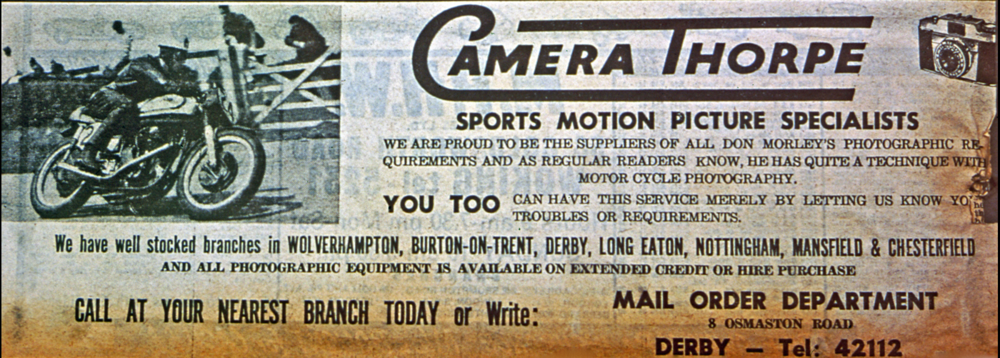 My local dealer even advertised their association with “the man who extracted a Leica from the Ministry of Supply”
My local dealer even advertised their association with “the man who extracted a Leica from the Ministry of Supply”
I opted for the Ministry to send it to Camera Thorpe in Derby, my nearest dealer. The dealer then got very excited because they had never had a new Leica before and, this being still in the days of the black market, they offered me half as much again over the new price if I was prepared to go in and legally take possession but then sign it over to them. I declined.
Came the big day when I did go in to collect and I was horrified to find Leica had moved on by then from making the IIIf to the IIIg and that was the surprise package I received.
You might think it strange now but I was gutted. There I was having to pay my life savings for a camera I just did not like. It had grown bigger and was no longer the lithe compact the IIIf and its predecessors had been. And I hardly ever used a 50mm lens (and I still don’t) so the much-vaunted bigger viewfinder was a complete waste for me, especially as they had not merged it with the rangefinder into one eyepiece window like in the then-new M3.
This was especially apposite for me because my job was very dangerous and I much preferred to use a frame finder a) because we could see around it as well, and hence spy the odd race car with evil intent and b) because it covered all of our range of lenses and so did not need changing in the heat of the moment when, for instance, we were also trying to screw out a 90mm and screw in a 135mm.
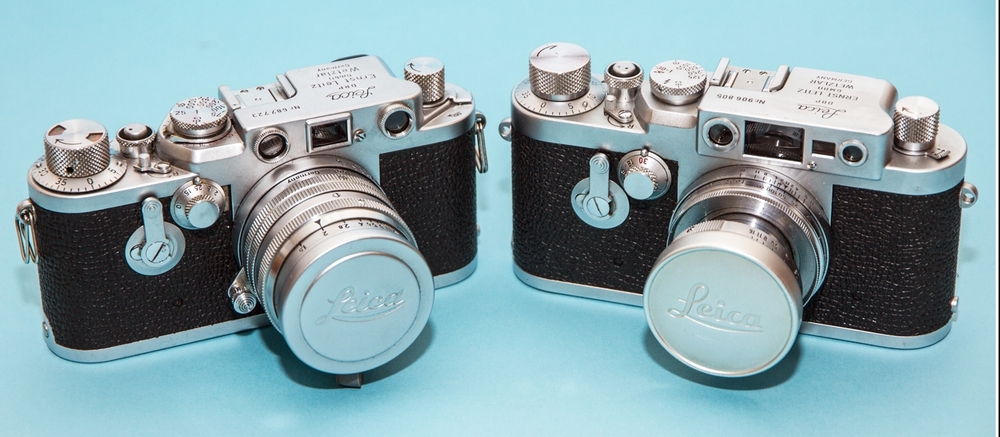 My current Leica IIIf and IIIg models. I was disappointed in the IIIg when it arrived unexpectedly, even though it was the latest model. But I came to appreciate it nearly fifty years later.
My current Leica IIIf and IIIg models. I was disappointed in the IIIg when it arrived unexpectedly, even though it was the latest model. But I came to appreciate it nearly fifty years later.
To cut a very long story short, I used the IIIg for six months or so and then managed to do a straight swap for a mint IIIf. I was happy again. The swapee thought it was Christmas and his birthday all rolled into one. But I never regretted the decision and never looked at another IIIg either until a couple of years back. Then I sort of rediscovered it and came to love it in the collector sense. Indeed, if I had to choose now, I might even take the g over the f, but it is still the IIIf which was THE big milestone for me.

A word on the pictures
Copyright Notice: All photographs in this article are the copyright of Don Morley and may not be downloaded or reproduced without express permission.
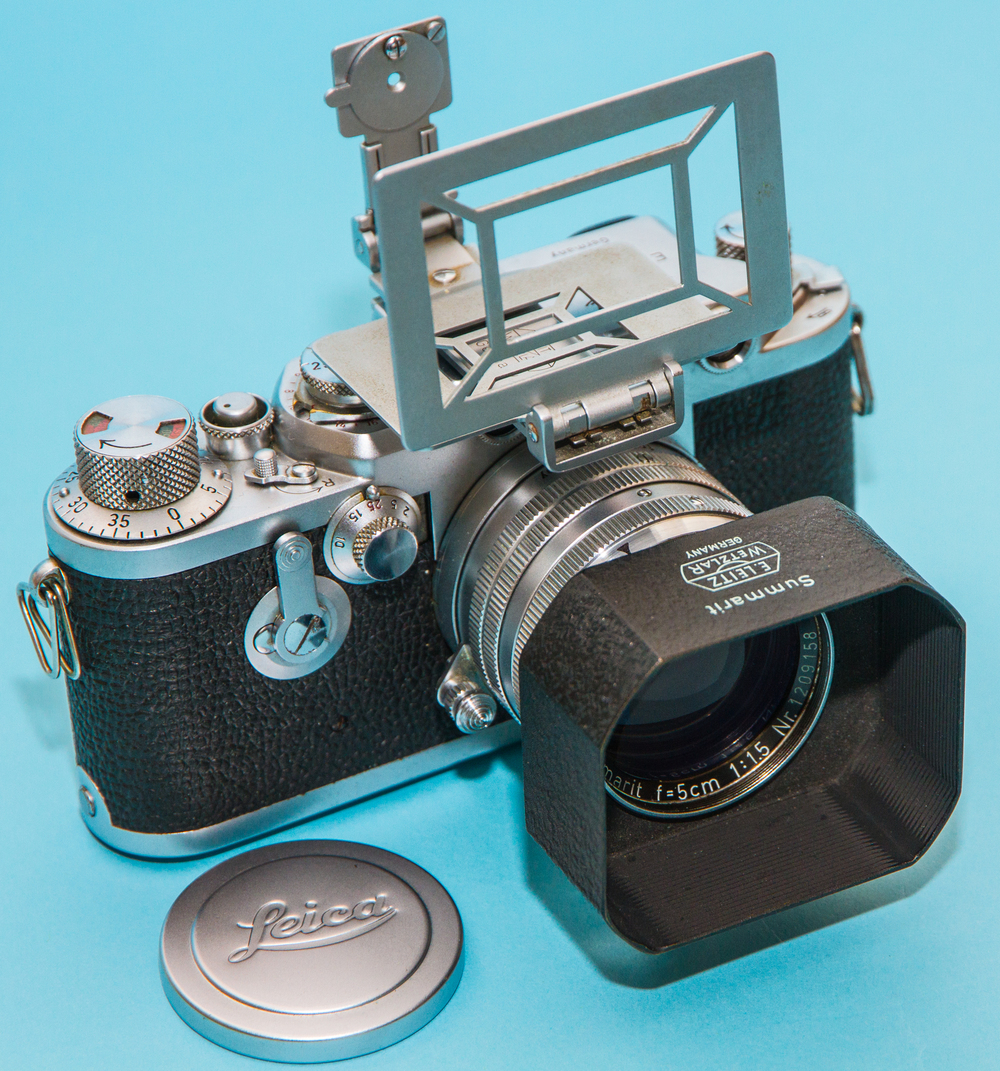
The shot at the head of this article and reproduced above is of my current 1954 red-dial and delayed-action IIIf with 1954 50mm f/1.5 Summarit lens fitted with its unique lens hood. On the camera is my (circa) 1954 Leica ROSUL viewfinder which has frames for 5cm, 9cm, 13.5 cm lenses. It was a vital accessory in those days for dangerous sports and better than the bright-line finders because you had to change them for each individual lens length.
This is not the actual camera and lens I used in 1954 (at least not as far as I know). But it is similar. Incidentally, I sometimes use the finder and the Summarit on my M9 and both work very well still for digital, though best to stop the lens down to f/2 or below and then up the contrast a bit in Lightroom or whatever.
IIIf and IIIg
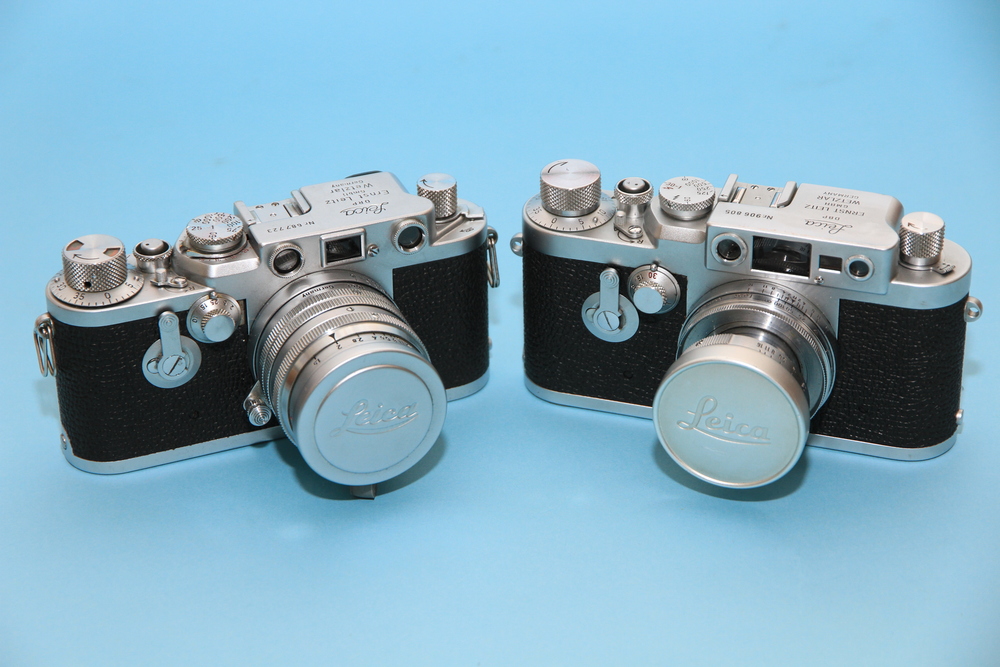
The view of the two cameras together shows the IIIf as above plus my 1957 IIIg and its 50mm f/2 Summicron, a lens I never managed to afford back in the 1950s. In fact, my original new IIIg came with a 50mm f/2.8 Elmar which I still have a soft spot for (I do have a mint M version). So neither cameras are my originals BUT both are same year as the ones I used in the fifties.
Press outfit
The picture of the outfit: This, again, is my 1954 IIIf with my screw thread lenses, some of which are very rare. So the camera is shown fitted to a screw-thread Leica Visoflex II (OTYDO) which in screw-thread fitting form is quite rare in itself (I have two), and, as shown, it has the (OTXBO) right-way-round pentaprism, then behind this, the picture also shows the upright magnifying finder/viewer.
The lens fitted is an ultra-rare E. Leitz Canada 280mm f/4.8 Telyt which is direct M rather than screw fitting and is quite rare in itself. My particular lens is even rarer still, so much so that not many of the most esteemed of Leica specialists have ever heard of it. It does, however, warrant few almost throwaway lines in Erwin Puts’s book.
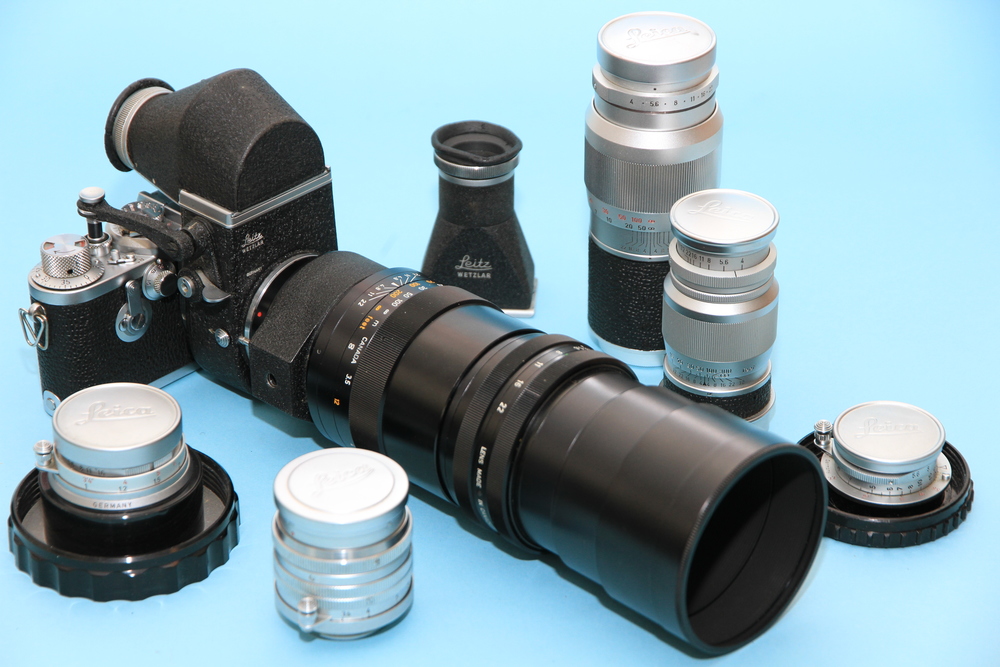
Basically, this is from the era when virtually all Leica’s lenses were made by Leica Canada rather than in Wetzlar. It was the time of the German Leica company’s first big financial collapse. The 280mm Telyt was re-designed by Leitz Canada so it was more suited for use on the R models as well as the M. They even changed the mount so it no longer needed the old OUBIO adapter which, on the previous version, was required both to fit and to be able to rotate it.
Anyway, as said, Canada much simplified all of this in addition to improving it optically, and these versions are also quite rare. What it seems even very few experts know about, they then had another 1980s go at making even more improvements to this lens just about the time the entire Leica company was imploding. [Editor’s note: In a comment to the original 2016 article, Dr. Andreas Kaufmann said: “the Canadian factory of Ernst Leitz never was closed. It exists until this day under the name of Elcan—Ernst Leitz Canada—and produced the last lenses around 2008 (f/1 Noctilux)]
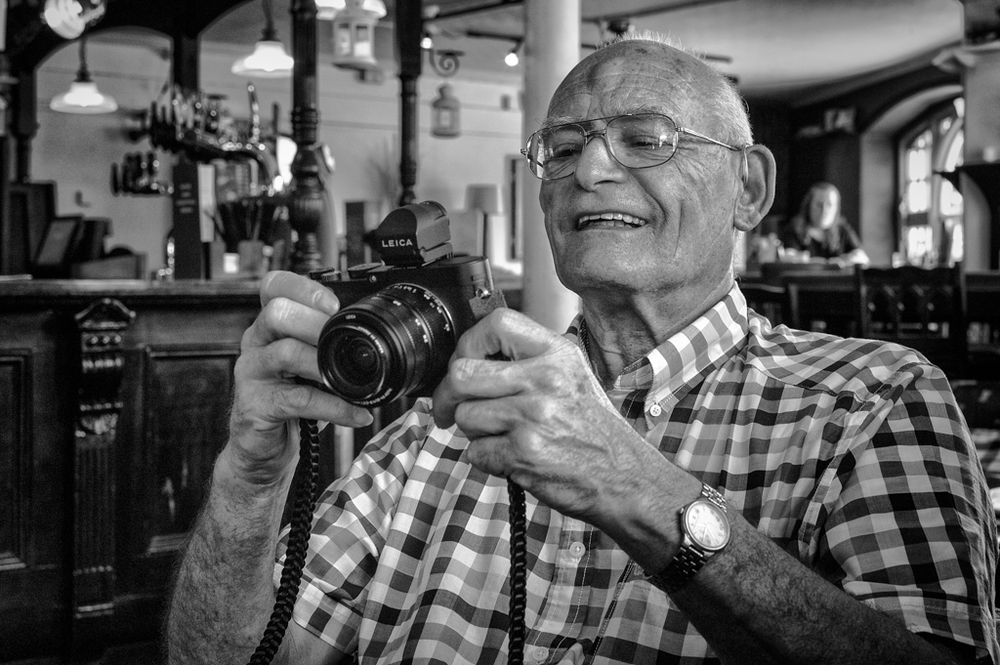 The author at lunch with Mike Evans in 2014, examining the then-new X Vario (photo Mike Evans, Leica M Monochrom, mark one, and Tri-Elmar MATE at 35mm)
The author at lunch with Mike Evans in 2014, examining the then-new X Vario (photo Mike Evans, Leica M Monochrom, mark one, and Tri-Elmar MATE at 35mm)
As said, Puts is the only writer I have known to pick up on this, and it does not look as though even he knows very much about the very final few; he just says something like “from lens number ……… this lens was re-designed optically to give better definition and contrast”.
Well, my lens is after that number, and I still have the box and its Passport, etc. It was not sold (by Leica UK) until 13 November 1984, which, if I recall correctly, was quite a long time after the Canadian factory had closed. Obviously I had a much earlier version back in the late 1950s.
Also in the picture are my 50mm Summarit and 50mm Summicron as already mentioned, plus a circa 1954 90mm f/4 Elmar and two other real rarities: My 135mm f/4 Elmar, which is very unusual in screw-thread form, and my even rarer 28mm f/5.6 Summaron of which Leica made only a relative few (fewer, in fact, than 4,000 in screw-thread form) and did not make at all as an M-fit lens.

A very interesting article Don, thanks. I like hearing about how it was done before auto focus and rapid fire shutters. The dodge of marking the point to focus on is one I still use. Except now I can remove it afterwards in Lightroom instead of having a Bentley park on top of it!
This was a great read and most interesting story. Oulton Park and Aintree were my nearest circuits and I fondly remember going, particularly to Oulton Park, in the mid sixties with my 111f and 135 lens. Needless to say my “keeper rate” was extremely low. These days with a 600mm F4 and Nikon D810 on “machine gun” setting it’s relatively easy but no where near as much fun.
Thanks again and stay safe and well.
I am just catching up as managed to bag another day off. Yippee.
Don this is an amazing story, and history of these wonderful cameras, and the quirky nature, and how you get the best out of them – I also read the entirety of the comments, so hats off to you.
I hope everyone is keep safe, and well. Hopefully things will improve soon.
Dave
Hello William and All, You ask how we did it in those days but we just did — not least in my case as I had absolute belief in the fact the equipment I had somehow managed to afford was THE absolute best meaning if I or my likes failed, then it was 100% my or our fault, NOT the cameras!.
Things were so very different in those days for example with such as no certainty or contracts of employment which given there were always 101 others out there wanting your job very often meant even we Staff men were decidedly unsecure.
The old adage in those days being ‘you are only as good as your last job’ and believe me it really was true as I can remember many a budding Pro photographer including several with very real promise being taken onto the staff, but then failing in some way or other before being kicked out again, and yes it also happened once to me, and it still B,well hurts!.
In a cruel sort of way though this also made the job even more exiting, interesting and very much more competitive as either you could do your job to the required level week in week out or you couldn’t, and for me at least making sure I had THE very best equipment to work with regardless of whatever my employers might have provided always seemed the most common sense approach.
Hence at Associated Iliffe Press for instance where Mike and I both once worked I was not overly popular with my fellow staff photographers as I alone provided my own equipment as featured in the above article, and yes I almost used to pre focus on the spot where I knew from experience the racing car or motorcycle must pass.
The way it worked for me because it was too difficult to accurately pre focus with such as a Leica rangefinder on such as a plain bit of road surface was I used to watch the Pre race practice periods VERY closely so as to be able to memorrise the car or bikes lines, I also always used to carry a small stick of blackboard chalk, and also some silver foil as used in cigarette packets and so the moment practice was over i used to dash out onto the track and either make a appropriate mark, or if the track had a rough surface like at the Isle Of Man TT, I would press a tiny bit of silver foil in instead..
Out of interest at the 1955 TT races the late great Geoff Duke hit my mark on every single lap, this system thus worked wonderfully and was almost foolproof if using my Leicas with rangefinder coupled lenses where I could focus very accurately on my mark, and then also see my subject hitting that mark in real time, though it took much much more skill to get the same success rate when using the Visoflex as there was a considerable delay between pressing the shutter and the picture actually being taken.
Problem was as I am sure most will know, the shutter got pressed indirectly by the Visoflex release arm which itself stood quite a long way proud of the shutter button, and then when you pressed it the Visoflex’s viewing mirror also had to be released or retracted before the exposure could commence, all of which meant umpteen milliseconds delay between when you first wanted to take the picture and it actualy happening.
This then is where the real skill came in or the men got sorted from the boys as you then had to make a mental calculation, for instance in my case based around on the fact any vehicle traveling at 60 mph covers 88 feet per second, so the likes of myself firstly had to become very adept at judging actual speeds, and then to be able to work that back in terms of how many feet were to be covered during the Visoflex’s delay period.
In short, this then meant our pressing the Visoflex shutter release that number of feet BEFORE said race car or race bike hit the mark I had pre focused on. Frankly I don’t think I could do it now, and before anyone asks it I should also mention I always found the Visoflex 11 quicker in use than the instant return mirror Visoflex 111, not east as the 111’s mirror stood even more proud away from the cameras shutter button.
Best wishes to all, and stay well. Don
Thanks Don. It is always great to get tips from a master like yourself. The Visoflex II is the one I have and, yes, there is a lag caused by the arm. And then you have to reset the mirror again to see anything. You have increased the level of my awe even further, particular as regards hefting that Visoflex and 280mm Telyt rig and then anticipating the lag and time taken by the car to reach the spot where you had pre-focussed. The older system with a Sports Finder and a smaller lens seems much easier.
Your mention of Geoff Duke at the TT reminds me of the MotoGPs and Superbike races which I attended in Qatar while I was working there between 2016 and 2010. Bikes are much smaller than cars and we could not get on the corners without a press pass and a mandatory yellow vest. Capturing someone like Valentino Rossi screaming past you at 215 mph was very difficult even with a, then state of the art, Nikon D3 and a 300mm f4 lens. The slightest jerk and the bike and rider would be outside the focus area and all would be lost. I did manage to get one really great shot one time which involved an Irish rider, Eugene Laverty, in a Supersports bike race. Laverty had been dicing with an Australian rider and it was the last lap with the Australian in the lead at the last corner. I turned the ‘motor drive’ on my Nikon up to the max and just blazed away. Laverty was ahead when he reached the finishing line and won the race. I looked at the back of my D3 and found that only one shot was in focus and it was just at the moment that Laverty took the lead. I could have been there for the next 10 years and would not have got another shot like it. I will send it to Mike, Dunk and yourself later by email.
Best Wishes
William
Fascinating and informative Don. And I wonder how many Macfilos’ Leica enthusiasts have now checked their Viso 280/4.8 Telyt lens’ serial numbers? E. Puts’ ‘Leica Lens Compendium’ documents the newer design’s ‘From’ SN.
A wonderful article and journey through the past. Thanks for sharing
Stay safe
Jean
Lovely article Don. That photo of the stricken Bentley and driver is wonderfully dramatic. And the soft colours really do convey that feeling of times past. I also like that photo of Jackie Stewart heading out for his first F1 race. Would you believe that about 25 years ago Jackie and I were both speakers on the same conference platform. Don’t ask me why, it would take too long to explain. I had lunch and dinner with him and found him to be an absolute gentleman, not at all conceited after his 3 World Championships, and very interested in what everyone else was doing doing and saying.
Moving on to the lovely cameras and lenses shown above. That version of the 280mm f4.8 Telyt is so rare that it does not appear on Collectiblend, the site that gives averages for auction outcomes. I have a IIIg and, while it is nice to look at, I prefer the f models as user cameras. I have never gelled with the g as a user camera and I am not sure why that is so. I have a couple of IIIf Red Dials, one with and one without a self timer. I prefer not to have anything under my right hand other than the camera and so I prefer the one without a self timer. I don’t use slow shutter speeds and I also prefer not to have a slow speed dial to give a cleaner grip for my right hand. Some years ago I managed to get one of the IIf Red Dial models with 1,000th sec top speed and it really is a lovely camera to use.
One of my IIIf Red Dials came with a Visoflex II. I use it for close up work with either the 65mm Elmar or with a wider range of lenses on a Leica bellows. My Visoflex is the early one with a non return mirror which has to re-set every time it is used. I presume that for a fast moving sport like motor racing that you had one with the automatic return mirror. The next issue is the weight. I find this rig heavy enough with the 65mm Elmar, but I don’t know how you managed with the 280mm Telyt. Did you use a monopod or a tripod with that lens? The Sports Finder would have been essential for fast moving racing cars. I presume that you pre-focussed somewhere around the middle of the track and then got the car in the middle of the appropriate frame for the lens you were using before shooting. Even with the Visoflex and the Telyt, pre-focussing would seem to have been essential.
Apart from the Telyt, I have most of the equipment you have shown above. I cannot imagine how I could begin to use such equipment to capture fast moving cars. Access was better then and, as you say, health and safety was not such a concern. I have a photo in a book by Louis Klemantaski of himself at the very edge of a grass verge at the side of a racetrack using a 135mm Elmar and with another Leica over his shoulder with a 3 lens rotating turret on it. There is absolutely nothing between him and the F1 cars going at full speed just a few feet away and yet his photos in the book (published in 1956) are all perfectly framed with no sign of shake. No IBIS, no autofocus, just perfect pictures. I doff my cap to you, Mr Klemantaski and all your colleagues from that era. And the drivers too, of course. Driver aids were minimal in those days. When men were men …..etc.
William
Nice comment William, and good article Don, thanks both.
This bit from William has resonance with me: “I prefer not to have anything under my right hand other than the camera and so I prefer the one without a self timer.”, it is almost my criteria for choosing a particular camera, and I didn’t understand that until I read the sentence.
I neither like anything under my right hand on the front of the camera, nor under my thumb on the back of the camera, which is why I liked the M4, and soon to come an M3, and why I am still really liking the MD 262.
It might be natural clumsiness, or the mere fact that most that is available under the right thumb is of dubious benefit, who can say?
Anyway, thanks chaps.
It’s the ball of my right thumb rather than the thumb itself that has always caused me most problems, particularly when it rests on the four-way pad and causes unwelcome happenings – I’m thinking of the CL, the old X Vario and X, the D-Lux 7 and, to some extent, the Q but not so much the Q2. It’s why I’ve been a great advocate of a lock on the direction buttons but no one seems to take any notices, other than those readers who agree with me.
We all have our own preferences as regards handling whether we are talking about film or digital. My own preference is for clean lines and a clean grip. I also like to have dials where I can see the settings before I raise the camera to my eye. Looking at flashing lights and numbers inside a camera viewfinder is not my preference at all, particularly with my poor peripheral vision. As for thumb pads and pressing buttons while the camera is to my eye, they are not for me at all. I don’t believe that having such items on cameras has improved the standard of photography at all. My dislike of the ‘thumbs up’ is a personal preference, of course. I believe that the best photographs come when the photographer is at ease with his/her equipment. Leica is better than most as, but not in respect of every aspect of camera handling. Many modern cameras have a multitude of features that are not really necessary for good photography. A lot of photographers would not get photos as good as Don Morley’s or Louis Klemantaski’s or Herbert Ponting’s or Frank Hurley’s or Cartier Bresson’s even with all the digital ‘whizz bangery’ of today. It starts and ends with the photographer’s eye. No more, no less.
William